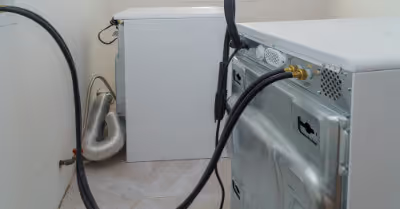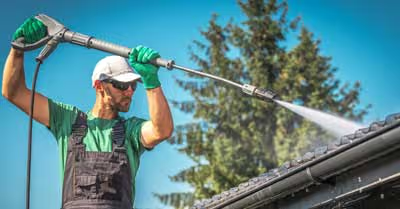Table of Contents
Types of Driveways
There are a few different types of driveways and it is good to know about all of them before you decide on a material. The main types are concrete, asphalt, gravel, and brick.
Generally, cracks will appear in asphalt and concrete driveways. However, there are some things you can do to reduce the chance of cracks. First, it is a good idea to look at the causes of cracks.
Causes and Prevention of Cracks in Driveways
There are several things that can cause cracks in a driveway and knowing what they are can help you prevent cracks in the future.
Poor Installation
Improper installation is the most common cause of driveway cracking. Typically, cracking will occur when the base or sub base is not constructed well. Make sure that you hire a professional, reputable driveway installation company. A quality driveway will use a crushed stone sub base that is tightly packed. Then, the aggregate base will be installed before the asphalt or concrete is poured on top.
How to Prevent:
Contractors may try to use sand or dirt as the sub base in order to save time and money. However, when these types of materials get wet, they will freeze and thaw continuously. This will cause the material to expand and contract which puts pressure on the surface of the driveway. This leads to cracks that could even be severe and compromise the integrity of the entire driveway.
Vegetation
Most of the cracks I have had in my driveway come from tree roots. Then, weeds will start to sprout inside the cracks which makes them grow and reduces the curb appeal of my home. As roots grow underneath and next to the driveway, the pressure will be uneven. The pressure will build as the tree grows until the driveway forms a crack. Roots will often make cracks that look like an “A” or cause lumps in the surface.
How to Prevent:
First, you should consider the locations of trees and roots before you install a new driveway. It may also be a good idea to install a barrier system for tree roots. However, this type of barrier may stunt the growth of the tree. Another solution is to remove the roots or even the tree itself.
Salt
Salt is often used to melt ice and to increase tire traction on a driveway. However, it is bad for the surface. This is especially bad for concrete driveways, but can harm asphalt as well especially if it is not sealcoated correctly. As the water is rapidly melted by the salt, it will seep into the surface and then refreeze. Then, it will put pressure on the surface which can often cause cracks.
How to Prevent:
Instead of using salt on your driveway during the Winter, opt to use sand. Sure, it will not melt the ice, but it should provide sufficient traction and will not ruin your driveway.
Weight
Even though concrete and asphalt are tough, strong materials, they cannot withstand unlimited stress and weight. Excessive weight on the driveway can put pressure and stress on it over time. This is especially true if the weight is always in the same place on the driveway surface.
How to Prevent:
The amount of weight that your driveway can withstand depends on the type of materials as well as how thick the material is. If you expect to have heavy vehicles or other objects on the driveway, you may want to think about having it reinforced. However, try not to have anything over 10 thousand pounds on the driveway if you can help it. I usually like to park my heavier vehicle or vehicles inside my garage and leave the lightest one out on the driveway surface to prevent excessive weight from adding to the strain on the surface.
Water
Poor drainage can cause water to seep underneath the driveway surface. This is especially true is you have drainage issues such as clogged gutters or downspouts or an uneven yard. When the water freezes, it can cause cracks in your driveway.
How to Prevent:
Do not route water away from your home and towards your driveway. Regularly clean out your gutters and downspouts and fill any lawn indentions in with soil. Keep an eye out to make sure that excess water flows away from the driveway. It is also a good idea to fill in any cracks that do form because water can seep into them and make the problem worse.
Heat
Heat can cause cracks in concrete or asphalt driveways. In concrete, there should be built in cracks for the driveway to expand. This prevents cracks, but occasionally cracks may still form. Asphalt does not have a place to expand to so it is more likely to crack under extreme heat.
How to Prevent:
Make sure that you have a reputable contractor install your driveway because they will take expansion into account and build the driveway appropriately. You should also regularly have an asphalt driveway sealcoated. Typically, you will want to have sealcoating applied every three years. This may also be a consideration for the type of material you use if you live in a very hot climate like I do.
How to Fix Driveway Cracks
The best way to fix driveway cracks depends greatly on the severity of the crack itself as well as the type of material the driveway is made of. Before using any of these methods to repair the driveway surface, be sure to remove any debris and pull out any weeds that may be growing in the crevices.
Resurfacing Products
If you have very small surface cracks, you will probably not have any issues with the structure or integrity of the driveway. However, they may not look too good so you probably still want to repair them. Good thing it is very easy to do.
First, make sure that the rest of your driveway is in good condition with no severe cracks, heaving, sinking, or crumbling. Then, you can purchase a resurfacing product from your local hardware store or online. Make sure you get a resurfacing product made for your driveway material since they make products for concrete and asphalt.
Resurfacing products are meant to create a durable bond with the driveway surface so that it can protect the surface from additional cracks. Make sure that you thoroughly clean the surface before you apply the resurfacer product. You should use a high-power pressure washer to ensure that the surface is adequately cleaned.
To apply the resurfacer, use a long handled squeegee. Apply the product to small sections of the driveway and move slowly and meticulously. Make sure that it is applied evenly and smooth it out. Also, use the squeegee in one direction so that the surface appears uniform.
Sealant
If you have cracks that are ¼ inches or smaller, you can likely repair them easily by filling them with sealant. You can use concrete crack sealant for concrete driveways and rubberized asphalt-emulsion crack filler for asphalt driveways. This is a great way to restore the appearance of your driveway and prevent these cracks from spreading. It will also keep water out that can further damage your driveway.
Since concrete and asphalt will expand as the temperature changes, make sure that you get flexible sealant. Before you apply the sealant, remove any debris. Then, make sure you apply it evenly and smooth it out so that you will not have bumps in the surface.
Patching
You can also use patching compound to repair asphalt driveways or concrete to repair driveways that are made out of concrete. This is a good way to temporarily repair severe cracks, but you may still want to consider resurfacing the driveway as well.
If you have deep cracks, be sure to fill them up to ¼ inches from the surface with sand before using the patching or concrete. Then, you will fill the crack about 90 percent of the way with the patching compound or the concrete mixture. Then, you will use sealant made for your material to fill it the rest of the way.
Be sure to wait until the concrete or patching is completely cured before you apply the sealant. Then, you will need to make sure that you smooth the sealant out on the surface of the driveway. Make sure that the sealant is dry before you use the driveway. Also, you may want to check the sealant to make sure the cracks are completely filled. If not, apply a second coat of sealer in the remainder of the cracks.
Recent Articles
















